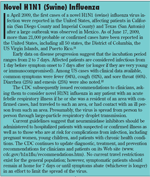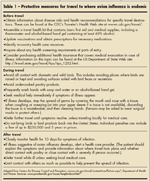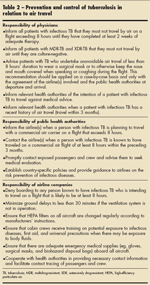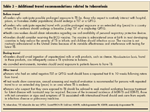- Clinical Technology
- Adult Immunization
- Hepatology
- Pediatric Immunization
- Screening
- Psychiatry
- Allergy
- Women's Health
- Cardiology
- Pediatrics
- Dermatology
- Endocrinology
- Pain Management
- Gastroenterology
- Infectious Disease
- Obesity Medicine
- Rheumatology
- Nephrology
- Neurology
- Pulmonology
Travel Medicine: Emerging Pathogens and New Recommendations, Part 1
More than half of travelers to the developing world experience a health-related problem during their trip, with 8% requiring medical attention on their return because of persistent symptoms. The GeoSentinel database, a collaborative effort among 31 travel medicine clinics on 6 different continents, suggests that the most common diagnoses in these persons continue to be malaria (24%), dengue fever (6%), acute traveler’s diarrhea (4%), and typhoid fever (2%).
Key words: avian influenza, novel H1N1 (swine) influenza, multidrug-resistant tuberculosis
More than half of travelers to the developing world experience a health-related problem during their trip, with 8% requiring medical attention on their return because of persistent symptoms.1 The GeoSentinel database, a collaborative effort among 31 travel medicine clinics on 6 different continents, suggests that the most common diagnoses in these persons continue to be malaria (24%), dengue fever (6%), acute traveler’s diarrhea (4%), and typhoid fever (2%).2

In recent years, however, the changing epidemiology of several pathogens has posed new risks to travelers. Among these are avian influenza, novel H1N1 (swine) influenza (Box), multidrug-resistant tuberculosis (MDR-TB), chikungunya virus (CHIKV) infection (ie, chikungunya fever), leishmaniasis, and dengue fever.
In our 2-part series, we discuss these emerging infections and summarize new travel requirements and vaccine recommendations. Here we focus on avian influenza, novel H1N1 influenza, and MDR-TB; in a coming issue, we will address CHIKV infection, leishmaniasis, and dengue fever.
AVIAN INFLUENZA
Influenza A virus of the H5N1 subtype, now known as avian influenza virus, is carried globally by wild birds and has caused significant morbidity and mortality among domesticated birds such as chickens, ducks, and turkeys. According to the World Bank, in Southeast Asia alone, avian influenza outbreaks since 2003 have resulted in the death or destruction of more than 140 million birds at a cost of more than $10 billion.3
Human cases of avian influenza are uncommon but have been reported since 1996. From 2003 to 2008, 369 human cases occurred in Asia, Africa, Eastern Europe, and the Middle East, resulting in 234 deaths (63% of cases).4,5 Most cases occurred in previously healthy children and young adults aged 10 to 19 years who had direct or close contact with H5N1-infected poultry or contaminated surfaces. In general, the H5N1 strain does not easily infect humans. It is difficult for it to spread from person to person, and prolonged contact is usually required for transmission to occur. For instance, in Thailand in 2004, probable transmission occurred between an ill child and her mother, and in June 2006 in Indonesia, 8 persons were infected in one family.
Although person-to-person transmission remains very limited,6 scientists are concerned that the H5N1 virus could one day gain the ability to infect humans and easily spread from one person to another. With little to no immune protection in the human population, a worldwide influenza pandemic could result.
Currently, the CDC does not recommend that the general public avoid travel to countries affected by the H5N1 virus. However, it does recommend protective measures before, during, and after travel to regions where H5N1 is endemic (Table 1).7,8

Clinicians should alert travelers to the signs and symptoms of avian influenza. They include not only typical symptoms of influenza but also conjunctivitis; GI symptoms, including nausea, vomiting, and diarrhea; and occasionally neurological changes consistent with encephalitis.6,9,10 Travelers should be instructed to seek medical care immediately if these signs and symptoms develop while they are traveling in a region where avian influenza is endemic or when they return home.
No vaccine is available to the general public to prevent avian influenza, although the FDA approved an H5N1 vaccine in April 2007 to be placed in national stockpiles in the event of an avian influenza pandemic.11 Likewise, no antiviral agent has guaranteed efficacy. Human strains of avian influenza virus have largely been resistant to amantadine and rimantadine. Oseltamivir and zanamivir demonstrate some efficacy, but data are limited and oseltamivir resistance has been reported.6,12
Currently, experts advise clinicians against routinely providing oseltamivir to persons who are traveling to regions where avian influenza is endemic. Travelers should be alerted to the potential health risks posed by counterfeit supplies of antiviral drugs that are available on the Internet or in countries with lax drug production and distribution regulations.13
Although 59 cases of suspected avian influenza were reported to the CDC between 2003 and 2006, on laboratory analysis, none were confirmed.14 In addition, no cases of avian influenza have been reported among international adoptees; however, the possibility exists, and like travelers, families preparing to adopt a child from abroad should be alerted to the signs and symptoms of avian influenza.15

MULTIDRUG-RESISTANT TUBERCULOSISMycobacterium tuberculosis infects one-third of the world’s population, and 8 million new cases of TB and 2 million associated deaths occur each year. TB is second only to HIV infection as a cause of death worldwide from a single infectious agent. TB risk among international travelers is well documented, especially among those who are visiting Africa, Asia, Latin America, and the former Soviet Union.16
Media attention focused on the acquisition of TB during air travel after a person with MDR-TB boarded an international flight against medical advice. First reports of TB transmission occurring in flight surfaced in the early 1990s, prompting the World Health Organization (WHO) to publish guidelines in 1998 for TB prevention and management during air travel. These guidelines were revised in 2006 in response to the increase in MDR-TB and the emergence of extensively drug-resistant TB (XDRTB).17 MDR-TB is defined as M tuberculosis infection that is resistant to isoniazid and rifampin, whereas XDRTB is defined as resistance to isoniazid, rifampin, any fluoroquinolone, and at least 1 of 3 injectable secondline drugs (ie, amikacin, kanamycin, or capreomycin).18
WHO guidelines state that short flights pose minimal risk of disease transmission, but flights of more than 8 hours may put passengers at increased risk, similar to the risk of TB transmission in other confined spaces. The highest risk is to those in proximity to the index case and is primarily limited to persons seated in the same row, to those 2 rows ahead or behind, and to crewmembers working in the same cabin area as the index case. Physicians who counsel patients regarding international travel should familiarize themselves with these guidelines, especially as they pertain to physician responsibilities (Table 2).17

Greater than the risk of TB acquisition during international air travel is the risk of TB acquisition while visiting a country where the disease is endemic. Although the risk to shortterm travelers is low, the risk to longterm travelers to countries with a high incidence of TB may approach that of the local population and is especially high among health care workers. In a Dutch study of M tuberculosis infection among travelers to areas where the prevalence of TB is high, the risk of infection was 2.8 per 1000 person-months of travel for non–health care workers and 9.8 per 1000 person-months of travel for those with direct patient contact.19
Travel recommendations related to screening, prevention, and management of tuberculosis are outlined in Tables 2 and 3.20
References:
REFERENCES:1. Freedman DO, Weld LH, Kozarsky PE, et al;GeoSentinel Surveillance Network. Spectrum of diseaseand relation to place of exposure among ill returnedtravelers [published correction appears inN Engl J Med. 2006;355:967]. N Engl J Med. 2006;354:119-130.
2. Wilson ME, Weld LH, Boggild A, et al; GeoSentinel Surveillance Network. Fever in returned travelers: results from the GeoSentinel Surveillance Network. Clin Infect Dis. 2007;44:1560-1568.
3. The World Bank. Economic impact of avian flu. http://go.worldbank.org/DTHZZF6XS0. Accessed August 10, 2009.
4. World Health Organization. Cumulative number of confirmed human cases of avian influenza A/ (H5N1) reported to WHO as of 1 July 2009. www. who.int/csr/disease/avian_influenza/country/en/. Accessed August 10, 2009.
5. World Health Organization. World: affected areas with confirmed human cases of H5N1 avian influenza since 2003. http://gamapserver.who.int/mapLibrary/. Accessed August 11, 2009.
6. Centers for Disease Control and Prevention. Key facts about avian influenza (bird flu) and avian influenza A (H5N1) virus. www.cdc.gov/flu/avian/gen-info/ facts.htm. Accessed August 10, 2009.
7. Centers for Disease Control and Prevention. Outbreak notice. Human infection with avian influenza A (H5N1) virus: advice for travelers. www.cdc.gov/ travel/contentAvianFluAsia.aspx. Accessed August 10, 2009.
8. Department of Health and Human Services. Keep bird flu out of the United States [poster]. www.pandemicflu.gov/issues/keepbirdsout.html. Accessed August 10, 2009.
9. Apisarnthanarak A, Kitphati R, Thongphubeth K, et al. Atypical avian influenza (H5N1). Emerg Infect Dis. 2004;10:1321-1324.
10. de Jong MD, Bach VC, Phan TQ, et al. Fatal avian influenza A (H5N1) in a child presenting with diarrhea followed by coma. N Engl J Med. 2005;352: 686-691.
11. US Food and Drug Administration. FDA approves first US vaccine for humans against the avian influenza virus H5N1. www.fda.gov/bbs/topics/ NEWS/2007/NEW01611.html. Accessed February 9, 2009.
12. Centers for Disease Control and Prevention. Questions and answers about avian influenza (birdflu) and avian influenza A (H5N1) virus. www.cdc. gov/flu/avian/gen-info/qa.htm. August 10, 2009.
13. US Department of State. Pandemic influenza fact sheet. http://travel.state.gov/travel/tips/ health/health_1181.html#. Accessed August 11, 2009.
14. Ortiz JR, Wallis TR, Katz MA, et al. No evidence of avian influenza A (H5N1) among returning US travelers. Emerg Infect Dis. 2007;13:294-297.
15. Staat DD, Klepser ME. International adoption: issues in infectious diseases. Pharmacotherapy. 2006; 26:1207-1220.
16. Fitzgerald D, Haas DW. Mycobacterium tuberculosis. In: Mandell GL, Bennett JE, Dolin R, eds. Principles and Practice of Infectious Diseases. Vol 2. 6th ed. Philadelphia: Elsevier Churchill Livingstone; 2005:2852-2886.
17. World Health Organization. Tuberculosis and air travel: guidelines for prevention and control. 3rd ed. Geneva: WHO; 2008:1-65. http://www.who.int/ tb/publications/2008/WHO_HTM_TB_2008.399_ eng.pdf. Accessed August 11, 2009.
18. Centers for Disease Control and Prevention. Multidrug-resistant tuberculosis (MDR TB). http:// www.cdc.gov/tb/publications/factsheets/default. htm. Accessed August 11, 2009.
19. Cobelens FG, van Deutekom H, Draayer-Jansen IW, et al. Risk of infection with Mycobacterium tuberculosis in travellers to areas of high tuberculosis endemicity. Lancet. 2000;356:461-465.
20. Centers for Disease Control and Prevention. Tuberculosis. In: Arguin PM, Kozarsky PE, Reed C, eds. Health Information for International Travel, 2008. Philadelphia: Elsevier Inc; 2007. www.eid.ac.cn/ MirrorResources/2966/yellowBookCh4-TB.aspx.1. html. Accessed February 9, 2009.
21. Centers for Disease Control and Prevention. Novel H1N1 Flu Situation Update. http://www.cdc. gov/h1n1flu/update.htm. August 7, 2009. Accessed August 11, 2009.
22. Novel Swine-Origin Influenza A (H1N1) Virus Investigation Team, Dawood FS, Jain S, Finelli L, et al. Emergence of a novel swine-origin influenza A (H1N1) virus in humans [published correction appears in N Engl J Med. 2009;361:102]. N Engl J Med. 2009;360:2605-2615.
Therapeutic agents in this article
Amantadine (Symmetrel)
Amikacin (Amikin)
Capreomycin
Isoniazid (Nydrazid)
Kanamycin
Oseltamivir (Tamiflu)
Rifampin (Rifadin)
Rimantadine (Flumadine)
Zanamivir (Relenza)
